World Map Depicting Traditional Tile Designs From Every Country
Decorative tiles are a quiet miracle: durable, hygienic, low-maintenance, and endurable. Their aesthetics have evolved over thousands of years.
But, perhaps because tiling as an industry took off in Victorian times, the wonder of the tile is often overlooked. After all, can there be true glamour in a decoration whose use depends on a substance called ‘grout’? Actually, yes. From vintage patterns to streamlined sophistication, tiling can make anybody’s bathroom or kitchen a place they want to be.
While some cultures have a world-famous tiling tradition from which to draw inspiration, others are less well known. That’s why QS Supplies decided to create a mapped guide to the most desirable tile designs from every country on Earth…
Table of Contents
World Map
Ceramic tiles are one of the oldest forms of material art. Besides their sustainability and captivating beauty, they reveal a lot about a place’s history and culture. Tiles have been used worldwide for thousands of years, adorning the interiors and exteriors of buildings, from cathedrals and palaces to the everyday home. Most nations have their unique design styles. Some have changed throughout the years, whereas some remain unchanged and are just as popular today.
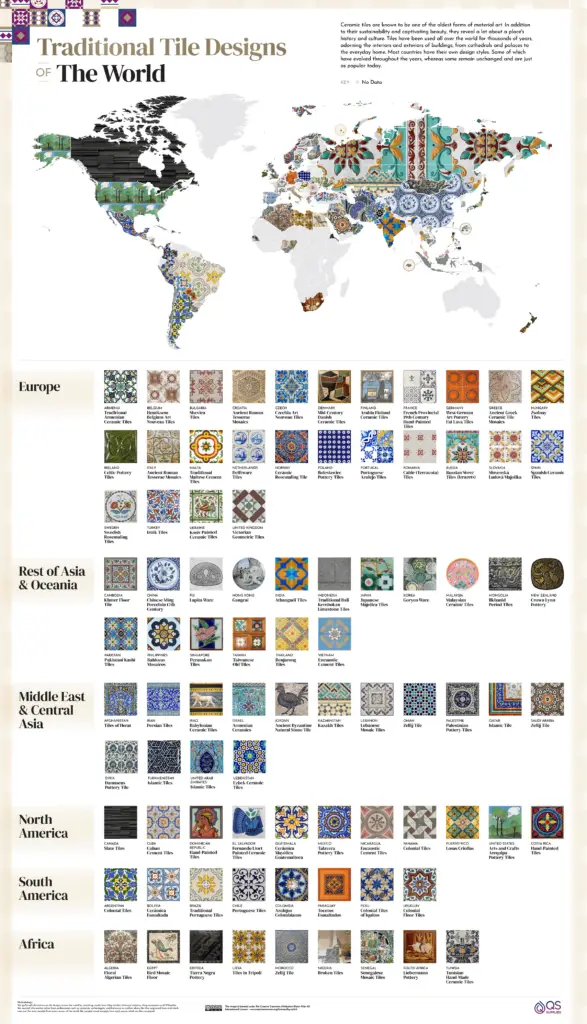
Europe
Ceramic tiles have been displayed and crafted since the 4th century worldwide. In the 16th-17th century. Modern Europe saw the rise of Delft tiles, which helped influence tile designs all over Europe in modern society. Delft Tiles were originally Chinese porcelain designs but soon integrated into Dutch imagery and later into other counties in Europe. On the other hand, Greek mosaics are known to be some of the earliest forms of art, dating back to the 3rd Millennium BC.
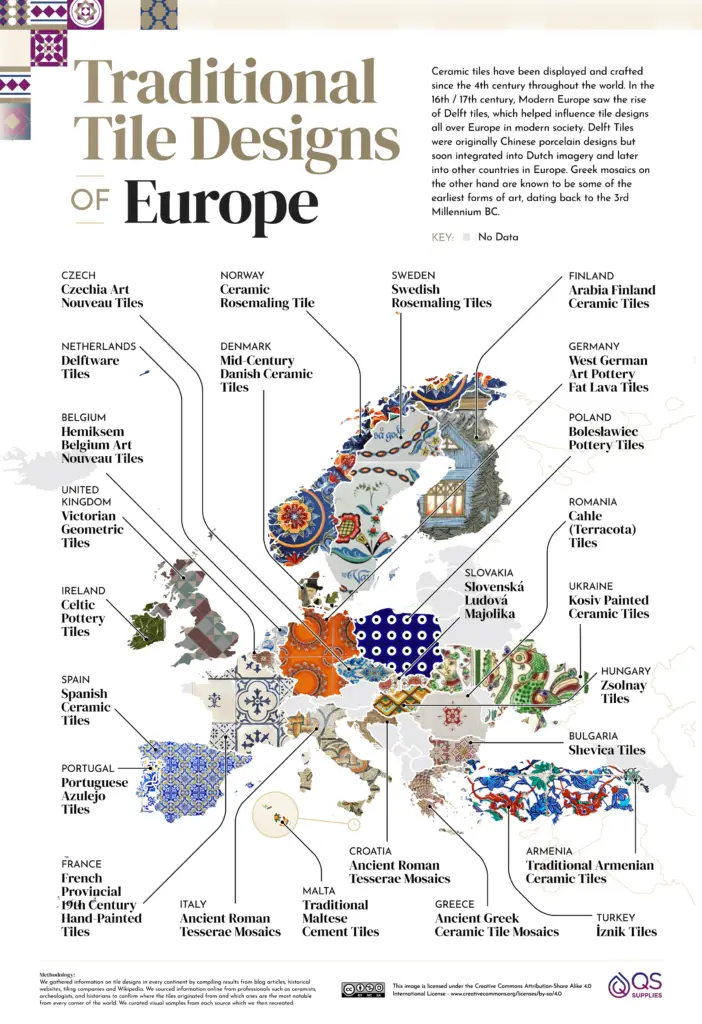
The Middle East and Central Asia
Popularity in handmade and hand-painted ceramics flourished during the Islamic Period, where you would find stunning tile works in Tunisia and Iran dating back to the 9th century. Known for their distinctive style, Iznik ceramics were produced in the 15th century during the Ottoman Empire, their design combining traditional Ottoman arabesque patterns with Chinese elements.
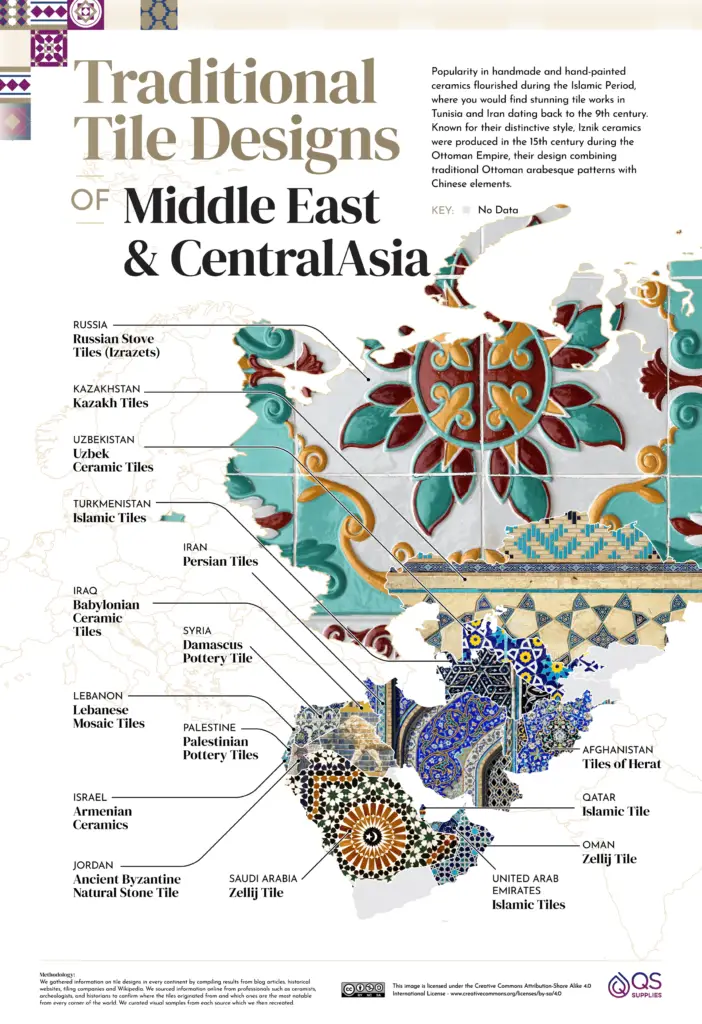
North America
Although Ceramic tiles only began their journey in the United States around the 1870s, other countries in North America, such as Mexico, had their own traditional Talavera Spanish Pottery Tiles, which began in the 16th century. Its ceramic techniques were known to be of Indigenous, Spanish, and Italian influence. Cuba, El Salvador, Puerto Rico, Panama, and the Dominican Republic also use similar styles and designs that are influenced by the Spanish during the 16th century.
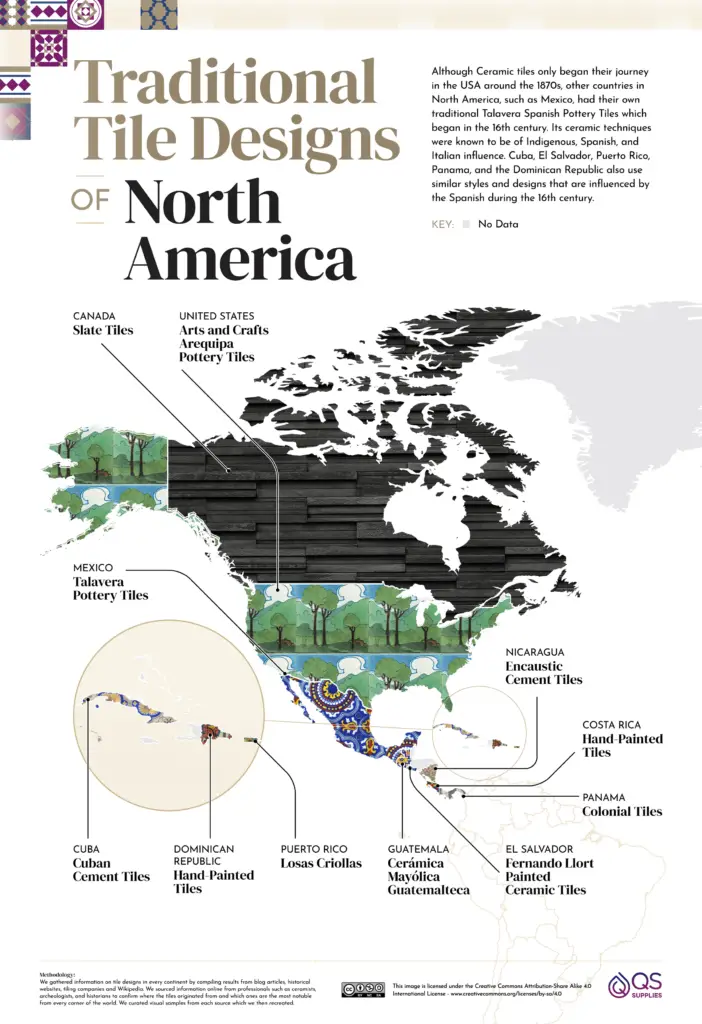
South America
Azulejos heavily influenced South American tiles, a form of Portuguese and Spanish painted tin-glazed ceramic tile that dates back to the 16th century. With bursts of yellow, red, blue, white, and green, these beautifully designed tiles are an ornamental art form. They typically feature images, such as flowers, suns, and specific geometric patterns.
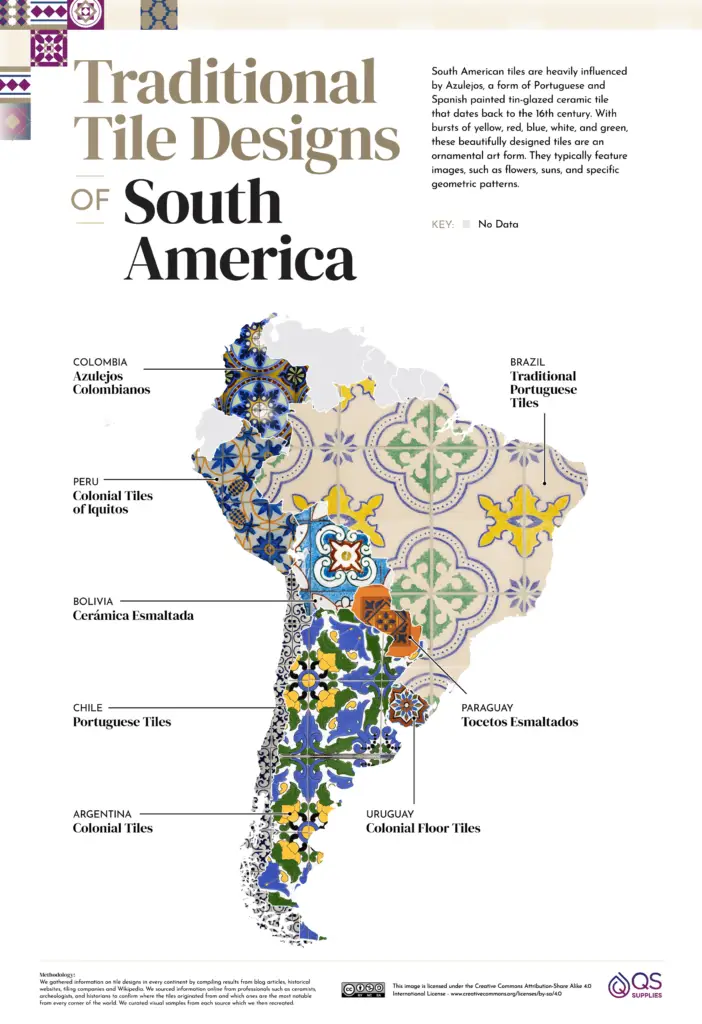
Africa
It is believed that the earliest form of tile making came out of the Holy Land and in North-East Africa, around the 3rd and 4th centuries BC. Zellij tilework is a particular ceramic that is popular in Moroccan architecture. Originating from Islamic artwork, this mosaic style is made from hand-chiseled tile pieces set with a plaster base. Tunisian ceramics captured the true beauty of enameled tiles and pottery in the 18th century. This continued in Nabeul during the 20th century, after the city became the capital of Tunisian ceramics.
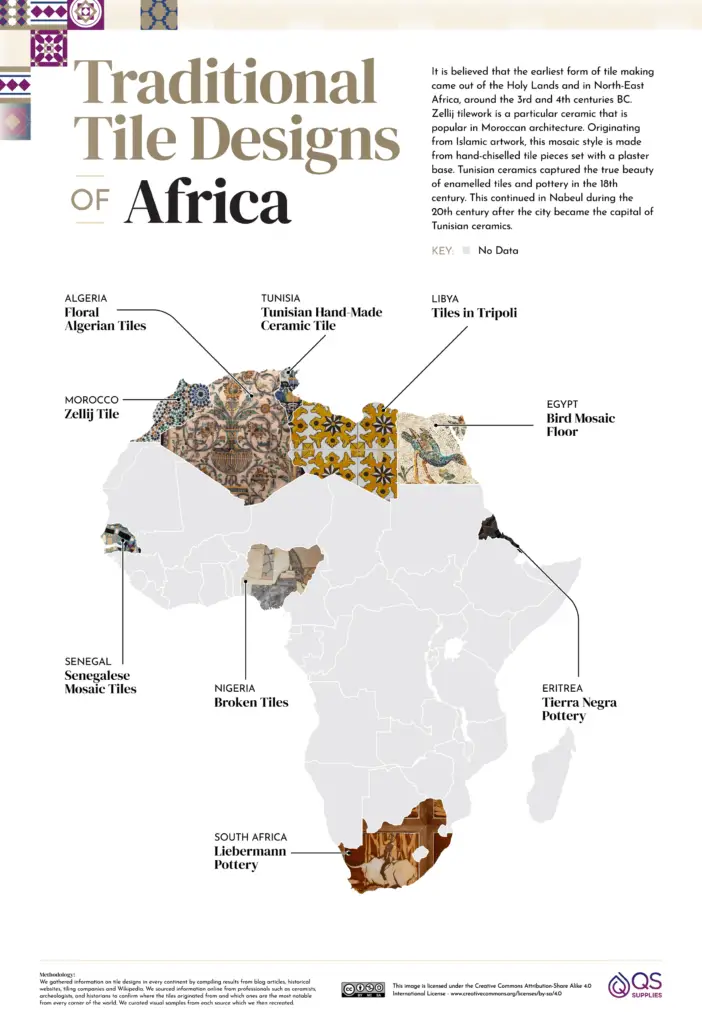
Asia and Oceania
China has been producing tiles for the mass market for thousands of years, with porcelain being extremely popular in the 17th century. Chinese Ming porcelain is a unique blue and white design used for tiles, plates, and bowls. Other countries in this corner of the world, such as Japan and India, were greatly influenced by designs from around the world, ranging from traditional Islamic designs and patterns to 19th-century Victorian styles.
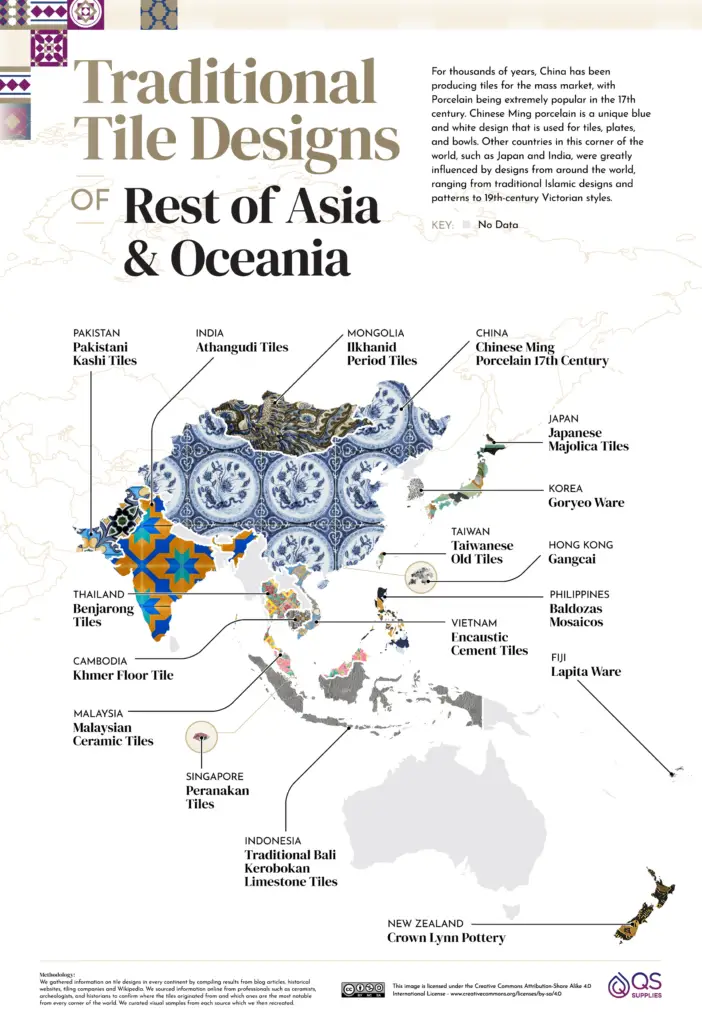
Methodology
QS Supplies gathered information on tile designs throughout every country across the world. They began by working through a list of countries and getting notable design styles.
The team cross-referenced this with information found on Pinterest and Dreamstime, which gave us a grand vision of how tiles look worldwide and the subtle/vast differences between them.
The world of tiling dates back to as early as the 4th century BC. From that point, Egyptians, Assyrians, Babylonians, Ottomans, Victorians, Chinese, and the Dutch all had an artistic ideology around art, and all similarly took influence from previous styles and designs. This meant a comprehensive approach was required to ensure our information was correct. To ensure this, QS Supplies sourced information from professionals such as ceramists, archaeologists, and historians to decide which tiles originated from/are the most notable from every corner of the world.
I collected the data in February 2022.









In the Algerian Hammadid era (around 11th century) there was this geomatric type of tiles (see photos attached to this email) and also in the Algerian Zianid era (around 14th century) there was this kind of geometric tiles, according to material proofs (look on the photo attached on the email). The Roman tiles (25BC) in Algeria (Cherchell city) and also in Theveste (Tenessa city now, Algeria), these kinds of tiles are different than the geometric tiles.
Moroccan geometric tiles are the same as Algerian geometric tiles, in fact, this kind of art was transmitted from East to West by Algerian tile artists that came from Tlemcen city (Algeria) and Algiers city (Algeria) in many eras in the history. Moroccan tiles doesnt have anything special, its the SAME as the Algerian tiles (in terms of colours, shapes, methods, materials,…).
The attached photos are from different eras (11th century, 14th century, 17th century, 21th century,…), there are references of Tachfine’s School (medersa tachfinia), Qal’at bani hammad (Beni Hammad Castle), Theveste tiles (Tebessa city tiles), Cherchell tiles, some photos of stamps representing geometric Algerian tiles (year 1999)…
So beautiful!